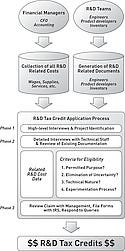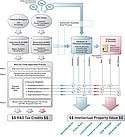Uncovering Value In R&D Tax Credit Processes Through Strategic IP Management
Medical device manufacturers in the United States, Europe, and Canada are capitalizing on government incentives designed to encourage research and development. Most such incentives come through tax-based programs. These programs return a portion of the costs associated with qualified R&D activities to companies in the form of tax credits. Companies pursuing the tax credits must engage in a vigorous application process that requires thorough documentation of R&D activities and their related expenditures.
Medical device manufacturers in the United States, Europe, and Canada are capitalizing on government incentives designed to encourage research and development. Most such incentives come through tax-based programs. These programs return a portion of the costs associated with qualified R&D activities to companies in the form of tax credits. Companies pursuing the tax credits must engage in a vigorous application process that requires thorough documentation of R&D activities and their related expenditures. For most companies engaging in ongoing R&D, the process is well worth the effort—depending on the state and country, tax credits can range from 6% to 50% of qualified R&D expenditures.
Click to enlarge |
Jed Cahill |
Click to enlarge |
John Cronin |
Click to enlarge |
Brian Cookson |
Most innovative companies understand the benefits of existing R&D incentive programs. However, what most companies do not know is that they can create significant additional value through the R&D tax credit process by connecting it to strategic intellectual property management. This additional business value is created by, one, identifying more R&D activities that may qualify for tax credits, and two, extracting new technology IP that can be leveraged in the business. This article describes the natural, but largely unknown, process synergies between R&D documentation and IP extraction that offer a significant source of business value.
Four Qualifying Criteria for Credits
In the United States, the R&D tax credit program is a federal tax incentive that permits companies to earn the credits upon incurring qualified R&D expenditures. These four criteria must be met in order for a project to qualify for R&D tax credits:
•It must have a permitted purpose, i.e., one in which the company is developing a new product or process.
•It must eliminate uncertainty by attempting to overcome a technological obstacle.
•It must be technical in nature, involving R&D in a specific field of science.
•It must involve a process of experimentation in which the project eliminates uncertainty.
In general, companies that create or improve products or processes can qualify for R&D tax credits. Identifying eligible R&D projects is where most companies struggle. Often, companies attempt to identify R&D as it relates to commercial or cost issues. However, R&D tax incentive programs require companies to demonstrate that a technological obstacle had to be overcome through experimentation, which requires an analysis of projects at the technical level. The more technological problems encountered and resolved through experimentation, the greater the chances that a project qualifies as R&D, over and above routine development via standard practices.
A key challenge for project identification is that most of the activities and recoverable costs typically occur through “shop floor” R&D performed in tandem with day-to-day commercial production. These activities potentially qualify and must be accurately identified and disentangled from nonqualifying development activities, which are often driven by the same set of commercial requirements. It is extremely important that projects be identified at the proper level so that the amount of associated supporting activities and costs can be maximized while maintaining compliance with the four criteria above.
Depending on the specific method used to calculate R&D tax credits, federal R&D tax credits in the U.S. are approximately 6% of eligible expenditures. In addition, many U.S. states offer tax credits, which augment the federal ones, increasing the total credit to around 10%. The R&D tax credit earned can be offset against current, future, and past taxes paid. Most profitable companies receive a refund in installments or prior taxes paid upon filing their first R&D tax credit claim. After that, the company applies its credits against taxes it otherwise owes.
Under the U.S. R&D tax credit program, companies can claim direct labor costs and wages, supplies used in the process, and 65% of subcontractor costs associated with the qualified R&D project.
From the standpoint of tax planning for international enterprises, it is worth noting that many other countries offer R&D tax credit programs. For a U.S. parent with subsidiaries that develop new products or processes, countries such as Canada provide federal tax credits between 20% and 35% that are further augmented at the provincial level. The UK provides tax savings between 8% and 24%, and France provides refundable tax credits ranging from 30% to 50%. Australia, Ireland, Mexico, Spain, South Africa, and Austria are among the other nations offering similar incentives.
Any company that engages in product and process level developments in the normal conduct of its business should be taking advantage of tax credit programs. Eligible companies span a wide range of industries that includes medical devices. As rapid technological change puts more and more pressure on the R&D function for medical device manufacturers, these companies in particular are in a position to capitalize on substantial tax credit opportunities.
Thorough Documentation Is Important
Click to enlarge |
Figure 1. Figure 1. R&D tax credit application process (click image to enlarge). |
Figure 1 illustrates the process of applying for R&D tax credits. Careful and thorough documentation is very important, as the IRS periodically reviews R&D claims submitted by companies.
Phase 1. Interviews with key technical and financial staff. Phase 1 involves high-level interviews with key technical and financial staff to determine whether an R&D claim is warranted. It is important to get a holistic view of the company’s business structure so that all sources of innovation and development, as well as interactions between divisions, can be identified. In this stage, eligible projects are identified and rough estimates of eligible costs are assembled. The baseline calculation is reviewed and a list of documentation to support the claim is compiled. A report estimating the tax savings is then generated.
Phase 2. Preparation of the study. Phase 2 involves the preparation of a study, through a series of in-depth interviews and a detailed review of project documentation. The study sets out the R&D projects and related activities, and provides a rationale supporting the eligibility of projects and activities with respect to the program’s four criteria.
Eligible costs are identified and allocated to the R&D projects at the activity level. This should involve technical staff, which is in the best position to judge the allocation of labor effort and R&D material used against project technological goals. Accounting staff can then collect and organize W-2 forms, invoices, time slip data, and other related accounting and transaction data.
In this manner, documentation collected at the project activity level is integral to a claim for R&D tax credits. I allows costs to be allocated and supported regardless of the R&D project’s scope, thereby maximizing of eligibility against the four criteria. The documentation also demonstrates the connection between eligible technical activities and their financial costs to the IRS, which will review this corroborating evidence.
Key documentation to be kept includes progress reports, lab notes, notebooks, specifications, technical plans, test results, e-mails, correspondence with customers and suppliers, and minutes of technical meetings. The information collected should be consolidated, organized, and related to the four criteria discussed above: permitted purpose, elimination of uncertainty, technical nature, and process of experimentation.
Phase 3. Review claim for accuracy and file with IRS. Phase 3 involves a review of the claim with management to ensure that all information is accurate and factual. All the supporting documentation must be maintained on file in the event that the IRS wants to review it. Finally, the appropriate R&D tax forms are completed and the claim is filed with the IRS. This phase also includes responding to any follow-up requests from the IRS before tax credits are awarded.
Valuable Synergy
R&D tax credit programs with budgets of billions of dollars provide significant value to thousands of companies around the world every year. However, there is a clear synergy between the R&D tax credit process and intellectual property management processes that most companies are not capitalizing on to realize additional value through these programs. Two specific approaches for capturing value from this underutilized strategy are discussed below.
Strategy 1. Use invention scanning to extract IP value from R&D documentation. In the normal R&D tax credit application process, the company consolidates and organizes R&D-related documents that provide the technical proof needed for the required tax forms. With this documentation in hand, an efficiently managed company should answer two key questions. First, is the R&D information gathered in the tax credit process useful for any other business purpose? Second, is there any additional information missing from the documentation that could be used to increase our tax credit? A process called systematic invention scanning answers both of these questions.
Systematic invention scanning is an IP business process that extracts existing ideas, concepts, inventions, test results, strategies, and other intellectual assets in a database that is used to inform IP development and management decisions. Similar to the R&D tax credit process, invention scanning involves collecting, reviewing, and analyzing existing company documentation.
However, invention scanning takes documentation exploration to another level by mining potential inventions that could be protected with IP to maximize return on investment of the R&D activity. Intellectual property can be used in a number of different ways in order to maximize ROI on R&D and innovation. These include defining boundaries, protecting brand, generating licensing revenues, leveraging supply chain and transaction activity, and improving competitive advantage. Increasing perceived value for customers and shareholders is an another strategic use of IP.
Click to enlarge |
Figure 2. Extracting new IP from R&D documentation processes and using existing IP to identify more R&D activities that may qualify for credits (click image to enlarge). |
As shown in Figure 2, device companies also can use a systematic interview approach to extract existing ideas, concepts, inventions, and other intellectual assets that had not been documented through the normal course of business and R&D activity. This approach adds significant potential IP value over typical ad hoc processes for invention capture and IP documentation. Relative to the R&D tax credit application process, the interview method may also lead to additional evidence of R&D activity that may meet the four criteria for tax credit eligibility. This of course may lead to larger tax credits than may have been achieved otherwise.
Strategy 2. Use existing IP to identify more R&D activities that may qualify for tax credits. Companies that own patents, patent applications, invention disclosures, and even defensive publications can use the IP documentation to identify evidence of R&D activity that may qualify for tax credits. Since companies can tap prior work done up to three years ago in order to file an R&D tax credit claim, IP documentation created several months ago can serve as a source of potentially eligible R&D activity. Pursuing IP protection indicates that a significant amount of R&D has occurred and that the work completed in the development stages should also qualify for the tax credit.
Therefore, it makes sense to review existing IP documentation such as patents and patent applications for evidence of eligible R&D activity. As Figure 2 shows, there is significant potential overlap between the four criteria for R&D tax credit eligibility and the criteria for patentability: new; useful or susceptible of industrial application; and “nonobvious” or involving an inventive step.
For example, if an invention is “new,” it has likely eliminated a prior uncertainty that had not been overcome in the same way before. If an invention is “useful,” then it may be considered to have a “permitted purpose,” i.e., to have developed a new product or process that is useful in the marketplace. If an invention is “unique,” it may have required a substantial experimentation process to demonstrate operability and refinement of a unique solution.
With this conceptual framework in mind, a company can mine its existing IP for evidence of R&D activity, even R&D conducted several months or years ago, that could be claimed for tax credits. This exercise is particularly useful for a company that has not previously engaged in a robust R&D tax credit documentation and application process.
Opportunity Lies Ahead
Savvy R&D managers, product developers, and IP managers and professionals are in a position to uncover new sources of value for their companies by connecting traditionally separate business processes for R&D tax credits and IP management.
Step one is to determine whether your company has an existing R&D tax credit application process. If not, ask your accounting or tax department for an explanation as to why the company has not engaged in the process. Companies whose R&D activities potentially qualify but who do not engage in the tax credit application process are leaving substantial value on the table. Fortunately, in many cases, some or all of this value may be recouped for the last few years by starting today.
If your company does have an existing R&D tax credit process, Step two is to contact your IP manager or patent attorney to inquire about their understanding and any involvement in the process. The likely response is that there is no connection. Here is where your opportunity lies.
John Cronin is managing director and chairman of ipCapital Group Inc. (Williston, VT), an IP consulting firm. Jed Cahill is consulting manager of ipCapital Group. Brian Cookson is president and managing director of RDP Associates (Chicago), a firm specializing in R&D tax credits. Cronin and Cahill can be reached at 802/873-3200. Cookson can be contacted at 312/836-3702.
About the Author(s)
You May Also Like






.png?width=300&auto=webp&quality=80&disable=upscale)
